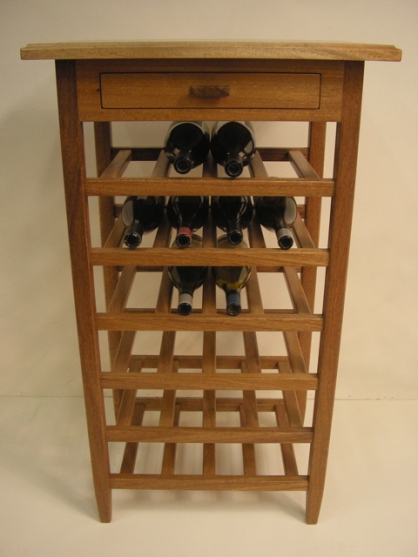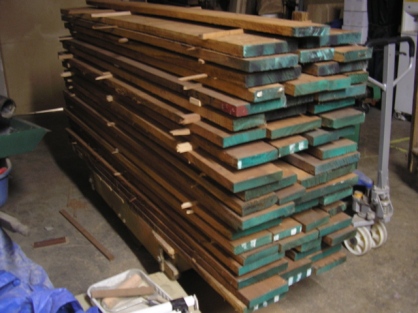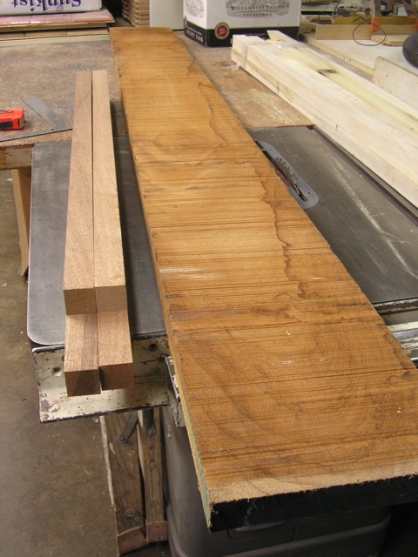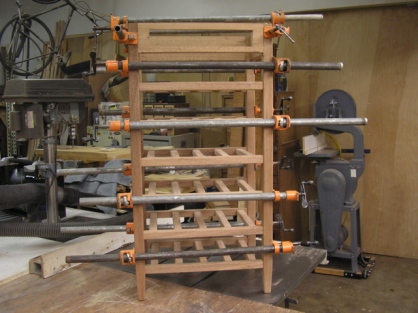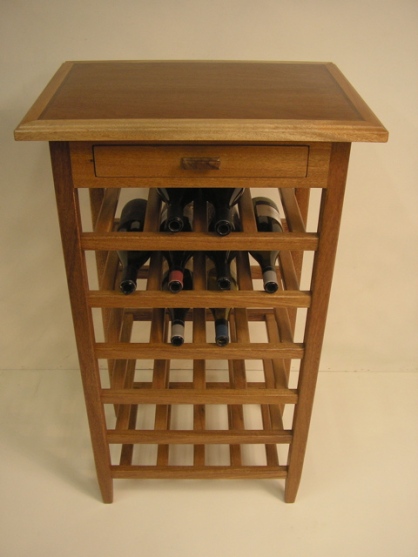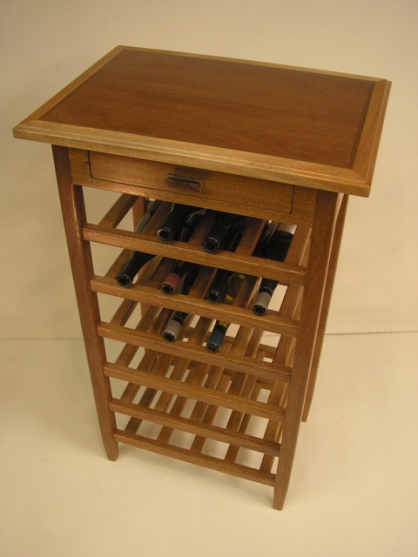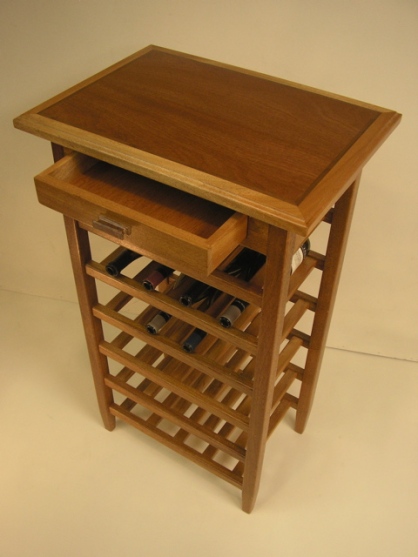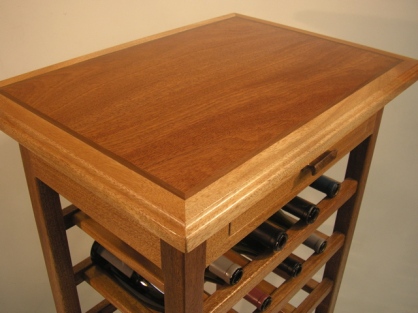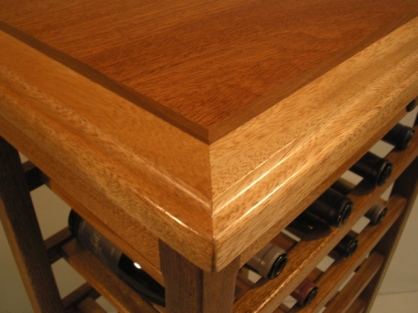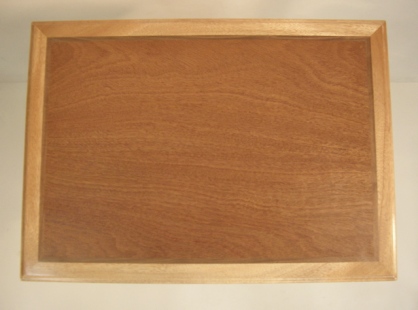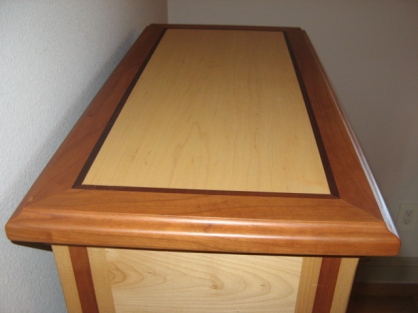Free and Knot Free Wine Racks…
March 26, 2011
Lavrens, my neighbor at the shop, came through for me again. He has a buddy who works or worked for a Canadian lumber wholesaler. A few years ago when the economy was still functioning, they bought units of exotic lumber to sell to high-end users. As the economy was destroyed, they went back to selling construction grade lumber and plywood. That didn’t work either so they closed the warehouse.
When they cleaned out the building, this unit of lumber was not in the inventory, so Lavren’s friend gave it to him, and he gave some to me. It is an African Mahogany called Khaya Ivorensis or commonly Khaya.
I cut one of the pallet skids in quarters for some legs. I was impressed by beauty of the grain and the color. It is fairly hard and dense. I don’t like the way the sawdust smells. It is a little acrid, but not horrible like Ipe, and certainly not as nice as real Honduras Mahogany.
These must have been some big trees because it appears like all heart wood. It mills up straight and true with no warping or cupping. Nice to work with and easy to machine.
Since I had quite a lot of material to choose from, I decided to make a piece that is narrow and a little taller. It holds 24 bottles and has a drawer for cork screws, stoppers and wine glass charms. 23 1/2″ wide x 16 3/4″ deep X 40″ tall.
The top turned out great. I planed a piece, crosscut it, then joined it back on itself for the field. You can barely see the joint.
I used Oregon Black Walnut for the feature strip and drawer pull.
The edge band was from a different piece of lumber. It’s pretty amazing how different the colors turned out from piece to piece. After I sanded everything off, the colors seem rather uniform. The urethane I use made the grain and true colors pop out.
While the grain and figure from piece to piece is very uniform, look how different the legs are compared to the carcase, and the edge band against the field on the top.
Like I said, free from any knots… and my favorite type of wood too… free. Thanks Lavrens!
Knot a Wine Rack…
January 16, 2011
It has been about a year since I started this blog. 2010 was one of the worst years I have lived through. Almost nothing went right, I never caught a break and almost every single thing I tried to do, blew up in my face. I feel like a complete failure.
Having said that, I’m not alone. It was hard for almost everybody I talk with. I got a message from WordPress telling me enough people viewed my blog to fill two 747 air planes. Lot of good it did. I got very few comments and even less interest in my wine racks. It’s very disapointing and some what frustrating.
I’m going to try an keep the shop going, but I don’t see how. I don’t have any emotional attachment to it really. Carpentry and wood working is what I have been doing for a living for a long time and I don’t really know what else to do. I going to try and keep going until I can’t anymore. I enjoy the work but it’s not who I am or what I’m about as a person, just a way to try and make money.
This is a piece I built last month for a lady. It is to be used as a night stand. The shelves are for shoes and slippers. She gave me some rough idea of dimensions that would fit in the room and how high it should be for a reading lamp.
I looked through my piles of hardwood lumber and dried logs, but there wasn’t enough to make all the parts I needed in the sizes I wanted. Here is a shot of some Clear Verticle Grain Fir that I re sawed. It came out of a nasty looking old 6 x 12 beam, salvaged from a construction site. While it had some defects and a big knot, it is beautiful material.
It must have been a giant old growth tree by the close growth rings and how many there are. I’m always in awe when I think that every grain was a year… we must be looking at decades… generations to grow this tree.
Here is what’s left of a 2 x 12 somebody gave me fifteen years ago. It has some curly grain to it that is very delicate and most gorgeous. I used it for the legs and the laminated edge-band on the top.
I love the look and color of fir. It is very difficult to work with because it can be splintery and it’s not hard enough to resist dings and dents in furniture. I went with it anyway because it was free. Here are a bunch of parts and you can see that I cut the drawer fronts out of the face frame and glued it back together so that the grain would run through.
Here I am with the tenon cutting machine I built, making round tenons to join the legs with the shelves. I call it the pencil sharpener, because it’s like sharpening big pencils.
When working with fir, you need to have very sharp blades, bits and planer knives or else you get heart breaking tear out or splinters. Sometimes you may run a bunch of pieces through the router table very carefully and think you have it licked… then WHAM, a blow out that rips the piece apart so that the material is wasted.
There are tricks to dealing with this like “Climb Cutting” where you run the work backwards agains the bit so it doesn’t grab the splintery grain…. or making multiple passes, taking a small amount at a time… or both. But, still you never know when the fir will bite you.
I was lucky this time, because I used every trick I know to machine all these parts right the first time. I barely had enough material to design this piece and no spare boards for mistakes and mishaps. In the end, there was barely enough scrap to kindle a fire!
I didn’t make the same mistake that I did on the last piece I built where I flipped the face frame in my haste to glue up the carcase. It’s subtle, but for those who know to look, they are rewarded with the grain running through the frame and drawer fronts.
I mortised my signature drawer pulls that matched the grain too. The last two from a batch of pulls I ran years ago. It takes six router set-ups to make them, so I do it in big batches of all kinds of woods so i don’t have to stop in the middle of a piece and make some.
The thing that took me the longest and was the most difficult, was to design the shelves. The boards I had were just too narrow to use. So I had to come up with a way to make them wider. I drew a dozen solutions but the one I liked the most couldn’t be built. I mean I could draw it, but there was no way to glue and assemble it… looked nice though.
The feature strip in the top is from my dwindling stash of old growth California Redwood. You can’t see in the photos, but there are small “Bird’s Eyes” in the Redwood.
There were two defects in the board I used for the field in the top. I could cut one out, but not both. So, the squiggle you see is a huge splintery check that ran through the whole beam. I glued it and clamped it. When it was planed off it came out smooth. Hey, it was made by hand! This ain’t IKEA.
I sprayed three coats of poly-urethane varnish on it, sanding between the first split-coat and second full wet coat. Then I rubbed out the top coat with double ought steel wool. It gets rid of any sheen and makes it velvety smooth to the touch. It’s virtually water and alcohol proof and pretty stain resistant too. Sometimes candle wax will stain it, but it is the toughest finish I know how to apply.
Over time, it will get used, dented, scratched and dinged. Like I’ve said before, some day after I’m long gone, somebody will pick this piece up, see my signature on the bottom and know that it took took time out of my life to make.
What Next?
The Art of Being an Artist…
August 27, 2010
I sold this console table at the Portland Saturday Market two weeks ago. I always ask folks who purchase my work, to send me pictures when my wine racks are in their new home stocked full of bottles. I got this photo in an e-mail. Pretty cool, my creation has found a good home. This piece was one of the first few prototype wine racks I built back in 2005. I had it in my house for a year or so, just to live with it, look at it and see how the glue joints and spray finish held up. Then it was in storage for a while and finally I need space in the shop, so I’m selling off my prototype/models.
I got to thinking about how I am keeping track of the products I make here in scenic Portland . I use a pretty simple system, The first two numbers are the sequence through year and the last two are the year. So this piece was the third one made in 2005, the year I built this shop and started branding the work.
In all the years I have built furniture, cabinets and woodworking projects in my shops, I never thought to sign the work. I ran across these photos recently and remembered how I began to sign and number my work.
In ’89 I was working off of scaffolding four stories off the ground, restoring the facade of an ornate old Victorian set of flats on Sutter Street in San Francisco. Somebody way in the past shot a gun into the air. Falling to earth, the bullet made a hole in the metal roofing that covered this conical roof. Throughout many years, water leaked into the attic through this dime sized hole. It drained into the front outside wall, down four stories all the way to the ground. With the exterior siding and trims constructed out of Redwood, they did not decay, but much of the wall and roof framing beneath it rotted away and the nails were crumbs of rust.
Above: a shot of the old rusted metal roof and the new galvanized sheet metal flashing I made to adhere the new “Torch Down” roofing membrane. Below: the finished roof.
My job was to gut the interior of the three flats and completely remodel the building. There was money in the budget to repair the facade of the building but not enough to address the horrible conditions that were hidden by 80 years of paint. My guys and I took most of the front apart to repair and replace the deteriorated framing and put it back together to appear as it did originally. We had a small carpentry shop set up in the basement, but much of the work of reconstructing the attic dormers and refurbishing the windows and trims, was done by hauling a table saw, chop saw, router table, etc, up on the scaffolding and cutting parts next to the work.
All of these big crown moldings I milled to match the existing shape down in the basement and then cut the joints up on a small platform. Meanwhile a painter spent three months stripping, sanding, prepping and priming the whole facade.
Above: Detail of galvanized metal flashing I fabbed in place. This shot is between the twin circle head dormers that light the attic, which I turned into a huge Master Bedroom and Bath with Jacuzzi. Everything on the exterior was caulked with a high-tech, flexible, paint-able adhesive caulking as it was assembled. I wish I could have used copper for the flashing, but there just wasn’t any money in the budget for any of this to begin with. It will still last another eighty years. Below: Owens Corning roofing material.
I can’t really relate how difficult and tedious it was to repair the siding and trims. It might have been easier and better to strip the whole front of the building and make it new, but there just wasn’t the money. Plus, we ran into costly problems restoring the curved windows and plumbing and mechanical issues too. When these places were built, they had gas light fixtures, no electricity, no hot water or heat.
Above: Column bases surrounding the attic windows. These dormers were the most time-consuming to repair, because the water leaked there first and the original construction was built to look good, not last for a hundred years of weather. Below: The circle head dormer roofs with new roof flashing.
I wish I had pictures of the interiors but these are the only photos I thought to take. The reason I tell this story is that I spent nearly a year of my life working on this building and had a few extremely close calls where I could have died in an instant.
October 17th, I called it a day for the first time in three months and sent my guys home ten minutes early. A few seconds later I was on the Central Freeway thinking, where is everybody? It’s rush hour and this place is deserted! I got out to the Candlestick Grade, saw the ball park and I remembered why we called it early… to go home and watch the World Series! That’s where everybody was. Seconds later, down by the SF Airport the magnitude 7.1 Loma Preita earthquake struck as I was driving.
Long story short, that part of the Central Freeway was eventually demolished from seismic failure. The building I was working on survived with minor drywall cracks. The seismic upgrades we did worked as designed. I had to go back and finish the job because the scaffolding rental cost a $1000 a week. The Saturday after the main quake, I was working on the pair of circle head dormers that lit the attic room. A 5.3 aftershock went off followed by a 5.2 about twenty minutes later. The scaffolding “walked” twenty-two inches down the street and didn’t topple over because I tethered it to the building. It got my attention for sure. We were so close to getting our carpentry work done, we just kept on going. People were streaming out of all the buildings surrounding us. The looked up at us and yelled, you guys are nuts!
My painting contractor was working on stripping 80 years of paint from the face of the dormers. He called me over to show me where the original carpenter had signed his work in a beautiful big flowing cursive scrip. I have built some pretty cool stuff for people with guts, vision and big checking accounts, but I never thought to sign my work. It was good enough to sign their checks.
Since I built my little shop here in the “UnderWorld”, I have been signing and dating the pieces I build. Not because I think it’s great work or that I am an artist, but simply to track my production and have inventory control.
I think my furniture pieces will probably outlast me. Who knows, someday in the 100th year of Antiques Road Show, the expert will see the serial #0305 and say this was an early piece, probably a prototype for what was to come. I wonder if that carpenter had any idea that his work would survive into the next century. In in ’04 I did a remodel/addition on a small commercial building here in Multnomah Village. The latest tenants have already torn off part of the front of the building and changed it again, so nothing lasts.
If the earthquakes hadn’t happened, I might have thought to add my name under his signature, or put a time capsule in one of the walls for some future restorer to discover.
I would like to think that my little pieces, just as objects, have a shot at surviving long after I am gone. I hope I can hang on here long enough to keep on designing and working. I have years worth of ideas and sketch books. As long as I can keep finding nice material, I think I can make pieces that people see and connect with. I hope I can continue to experiment and grow as a woodworker.
I feel like it has taken me five years be able to manufacture these wine racks pretty quickly on a small scale. Finding great material that will make the exercise worth my time and effort is going to be my biggest challenge.
When I look at objects, cars, buildings, art, etc, I always wonder about the minds that had the idea, drew the plan and made the things. I wonder how much time was spent, how much energy, how much frustration, what the feelings were at different points in the process. Was there a single person or a collaboration, different designers and builders? Were they pleased, disappointed or just glad to have work?
Someday a person that has done a little woodworking or is a person that has been involved in projects of any kind, might have the same thoughts looking at one of my pieces. They will turn it over and see my KTW brand and signature. They will know that they are looking at time from someone’s life.
The next trick is to figure out a way sell this stuff. The art of being an artist is getting paid for it.
